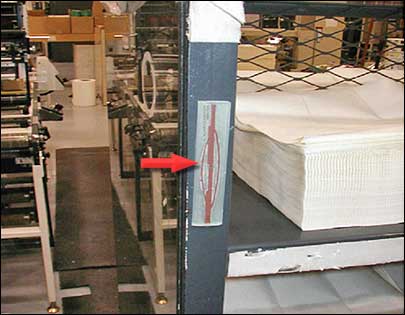Although automakers have long used RFID to track vehicles under construction as they move through some of their manufacturing plants, given that radio waves are reflected by metal, these tracking systems have required the use of active RFID tags (see RTLS Drives Efficiencies at BMW).
Now Avery Dennison, the world’s largest maker of self-adhesive labels, says it has developed and tested a new passive 915 MHz RFID tag design that the automotive industry can use throughout its operations. The company believes that by developing such a tag, it could leverage the development work and economies of scale that currently exist for the UHF RFID technology that is being deployed by companies in range of industries.
“In the automotive industry, goods don’t arrive in corrugated boxes but in metal and plastic totes, and nearly all the parts and components are metal. We saw a need for a UHF tag that could be used in this environment, and have spent two and a half years developing this antenna design,” says Brian Kady, new business development specialist at Avery Dennison’s Industrial and Automotive Products division.
The new tag—dubbed Metal Track—is 5.5 inches long, 1 inch wide and 0.3 inches deep (about 140mm by 25mm wide by 8mm) and features an Avery Dennison antenna especially designed to enable a passive tag to be read within a metal-heavy environment. Each tag contains an EPC Class 0 chip, a read-only IC that carries a unique serial number encoded by the chip manufacturer. The Metal Track tag can be made using EPC Class 0 chips from any chip supplier. Avery says its will give customers the ability to specify the chips to be used in their tags. However, there may be some limitations because chips are not all the same in terms of performance and reliability. Although the Metal Track tag is currently available only with a Class 0 chip, Avery Dennison is developing a version that contains an EPC Class 1 read-write RFID chip.
One key application for the tag, says Avery, is tracking the reusable transportation racks employed throughout the automotive industry to store and transport specific parts, such as car hoods. A hard plastic substrate encases the tag and keeps the antenna 4mm away from the rack’s metal surface on which the self-adhesive tag is mounted. In addition to the tag’s proprietary antenna design, the tag’s 4mm mounting distance is one of several features that enable the tag to perform on metal, says Avery.
Racks have to be specifically designed to carry a specific component. Not only are racks used in great numbers throughout the automotive industry, but they also represent a significant investment for automotive manufacturers. A single production plant may use between 5,000 and 10,000 racks, and a major automotive firm could use up to 1.5 million of these racks in their production systems around the world.
“At a cost of $1,500 each, the racks represent a significant investment,” Kady says.
Automakers currently use bar code labels to track racks, but RFID tags promise to provide a better, less labor-intensive method of tracking these racks into and out of production plants and are less likely to be damaged by exposure to rain and temperature extremes when the racks are stored outside, as they frequently are. According to Avery, most of the bar code labels that automakers currently use are not covered with a plastic laminate to protect them from the elements.
Only one tag need be applied to each rack, says Kady. Although the Metal Track tag has already proved capable of being read at a range up to 20 feet during trials with two of the three major U.S. auto manufacturers, the delivery doors where the RFID readers are deployed are no wider than 10 feet, requiring a read range of just 5 to 6 feet. Avery says that throughout trials with the two U.S. automakers, the tags are being read as they move through RFID portals at delivery doors at a rate of at least 95 percent. The trials, which started in June 2004, are expected to end in the third quarter, when the automakers should move to full implementation of the tags, according to the company.
Avery expects to price the Metal Track tag at around $6 each when released in the third quarter of 2005. The company says that the $6 price should not be impacted by a customer’s choice of chips, unless a customer requires chips that are not competitively priced. In addition, Avery says pricing could fall well below $6 with high enough volumes to warrant it


